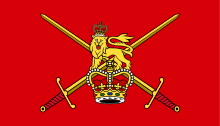Royal Logistic Corps
The Royal Logistic Corps (RLC) provides logistic support functions to the British Army. It is the largest Corps in the Army.[1]
| Royal Logistic Corps | |
|---|---|
 | |
| Active | 5 April 1993 - present |
| Country | |
| Branch | |
| Role | Logistics |
| Garrison/HQ | Worthy Down Station, Winchester |
| Motto(s) | "We sustain" |
| March | On Parade Lion, Sword and Crown |
| Commanders | |
| Regimental Colonel | Colonel C J Francis MBE ADC |
| Colonel-in-chief | The Princess Royal |
| Insignia | |
| Tactical recognition flash |  |
History
 |
| Arms of the British Army |
|---|
| Combat Arms |
|
|
| Combat Support Arms |
|
| Combat Services |
|
|
The Royal Logistic Corps (RLC) was formed on 5 April 1993, by the union of five British Army corps:[2]
- Royal Engineers Postal and Courier Service
- Royal Corps of Transport
- Royal Army Ordnance Corps
- Royal Pioneer Corps
- Army Catering Corps
The RLC comprises both Regular and Army Reserve units.[3]
The RLC is the only combat service support corps of the British Army with battle honours, derived from the usage of previous transport elements of the Royal Waggon Train, and their successors as cavalry. The battle honours are:[4]
Museum
The Royal Logistic Corps Museum was based at Princess Royal Barracks, Deepcut near Camberley in Surrey, but was closed prior to a move to Worthy Down near Winchester where it was to reopen in April 2021.[5]
Cap Badge
The RLC cap badge is an amalgamation of the cap badges of the forming corps:[6]
- The laurel and garter band is from the Royal Engineers
- The Indian star is from the Royal Corps of Transport
- The shield in the centre is from the Royal Army Ordnance Corps
- The crossed axes are from the Royal Pioneer Corps
- The motto, "We Sustain", is from the Army Catering Corps
The inscription on the garter band "Honi soit qui mal y pense" can be translated as "Evil to him who evil thinks".[1]
Structure
RLC units include:[7]
Regular Army
| Unit (with Army 2020 names) | Current Location | Future Location | Notes |
|---|---|---|---|
| 1 Regiment RLC (1 Close Support Logistic Regiment RLC) | St David's Barracks | St David's Barracks | To merge with 1 CS REME [8] |
| 3 Regiment RLC (3 Close Support Logistic Regiment RLC) | Dalton Barracks | Dalton Barracks | |
| 4 Regiment RLC (4 General Support Logistic Regiment RLC) | Dalton Barracks | Dalton Barracks | |
| 6 Regiment RLC (6 Force Logistic Regiment RLC) | Dishforth Airfield | Alanbrooke Barracks | |
| 7 Regiment RLC (7 Force Logistic Regiment RLC) | Kendrew Barracks | Alanbrooke Barracks in 2029 | 7 Regiment's history is heavily influenced by tank transporting and the Mixed Service Organization (MSO). The MSO was formed of Polish exiles and Prisoners of War who could not return home after World War II and served the British Army until the end of the Cold War. The Regiment's symbol is a Polish eagle (Orzel) on a Polish flag and a motto in Polish, Bialo Czerwoni ('the White and Reds').[9] |
| 9 Regiment RLC (9 Theatre Logistic Regiment RLC) | Buckley Barracks | Buckley Barracks | |
| 10 Queen's Own Gurkha Logistic Regiment RLC (10 The Queen's Own Gurkha Logistic Regiment) | Gale Barracks, Aldershot | Gale Barracks, Aldershot | |
| 11 Explosive Ordnance Disposal and Search Regiment RLC (11 Explosive Ordnance Disposal Regiment RLC) | Vauxhall Barracks | Vauxhall Barracks | 421 Headquarters Squadron 4 x EOD Squadrons |
| 13 Air Assault Support Regiment RLC (13 Air Assault Support Regiment RLC) | Colchester | Colchester | |
| 17 Port and Maritime Regiment RLC (17 Port and Maritime Regiment RLC) | McMullen Barracks / Sea Mounting Centre, Marchwood, Southampton | McMullen Barracks / Sea Mounting Centre, Marchwood, Southampton | Part of 104 Logistic Support Brigade. 51 Port Squadron, 52 Port Squadron, 53 Port Squadron, 54 Port Squadron, 79 Squadron, 17 Regiment Workshop, REME |
| 25 Training Support Regiment RLC | Princess Royal Barracks, Deepcut | Worthy Down in 2019 | |
| 27 Regiment RLC (27 Theatre Logistic Regiment RLC) | Travers Barracks | Aldershot | To merge with 2 Close Support REME.[10][11] |
| 29 Postal Courier & Movement Regiment RLC | Duke of Gloucester Barracks | Duke of Gloucester Barracks | Part of 104 Logistic Support Brigade. Made up of 55 (HQ) Movement Control Squadron, 50 Movement Control Squadron, 59 Movement Control Squadron, and 80 Postal and Courier Squadron |
| 2 Operational Support Group RLC | Prince William of Gloucester Barracks | Prince William of Gloucester Barracks |
- RHQ The RLC. located at the "Home of the Corps", Worthy Down Station, near Winchester. Headed by Col RLC.
- British Army Photographers, small trade group of professional photographer and videographers posted globally covering Army Media and instructing in specialist photography.[12]
- Defence Explosive Ordnance Disposal, Munitions and Search School (DEMSS) formerly the Army School of Ammunition until 2009.
- 15 Air Assault Close Support Squadron RLC (not mentioned in Army 2020). Attached to 13 Air Assault Support Regiment.
- ARRC Support Battalion (an All Arms unit with logistic squadrons making up the bulk of the battalion)
Notable minor units and joint units with a large RLC element include:
- 20 Logistic Support Squadron, London District
- 89 Postal and Courier Unit, (Supreme Headquarters Allied Powers Europe, Belgium)
- 105 Logistic Support Squadron, (British Army Training Unit Suffield)
- 132 Aviation Supply Squadron RLC, part of 7 Battalion REME within 16 Air Assault Brigade
- Cyprus Service Support Unit, (British Forces Cyprus)
- Joint Helicopter Support Squadron, RAF Benson, a combined RLC / RAF unit.
Disbanded Units:
- 2 Logistic Support Regiment RLC, based at Gütersloh. Formally disbanded in July 2014.
- 8 Artillery Support Regiment RLC - The Regiment formed in 1964 at Munster, Germany as 8 Transport Column, RASC at the height of the Cold War.
- 12 Logistic Support Regiment - Disbanded at Abingdon on 12 December 2013.
- 19 Combat Service Support Battalion - a combined unit with a logistical squadron and an Equipment Support company. Disbanded N Ireland December 2012.
- 23 Pioneer Regiment - a specialist pioneer unit with artisans, defence and Force Protection elements. Disbanded at Bicester November 2014.
- 24 Regiment - disbanded in Germany, 30 January 2014. Part of 104th Logistic Support Brigade.
Drivers, Technicians, EOD all selected from the RLC.
- 44 Support Squadron, (Royal Military Academy Sandhurst)
19 tank transporter squadron
Army Reserve
- 150 Regiment
- 151 (London) Regiment
- 152 (North Irish) Regiment
- 154 (Scottish) Regiment
- 156 Regiment
- 157 (Welsh) Regiment
- 158 Regiment
- 159 Regiment
- 162 Regiment
- 165 Port and Maritime Regiment
- 167 Catering Support Regiment
- 383 Commando Petroleum Troop
Former units
- 153 The Scottish Transport Regiment
- 155 (Wessex) Transport Regiment
- 160 Transport Regiment
- 161 Ambulance Regiment
- 163 Movement Control Regiment
- 164 Transport Regiment
- 165 Pioneer Regiment
- 166 Supply Regiment
Headquarters
The Corps Headquarters is at Worthy Down Barracks near Winchester. It is headed by a Colonel (Colonel RLC) as the professional head of the Corps. Col RLC is responsible for the Moral Component, regimental infrastructure and support and works to Commander Home Command. Col RLC remains responsible for the Corps of Drums, which often parades with the RLC Band. (AG).[13]
The RLC Band was formed in 1993. It provides musical support wgule also representing the Royal Logistic Corps, and on occasion, the wider British Army. The are only able to produce no more than 12 working ensembles at a time. These include a marching band, big band, fanfare team, and acoustic groups.[14]
Master General of Logistics
There is also a ceremonial head (instituted in 2009), who heads the Corps and its wider family such as the Associations and Cadets, known as the Master General of Logistics (MGL). Holders of the post include:
- General Sir Kevin O'Donoghue (2009-2012)[15]
- Lieutenant General Mark Poffley (2012–present)[16]
Publications
The Sustainer is the magazine of the RLC Association. The Waggoner remains the Journal of the RASC/RCT Association. The RAOC Gazette that of the RAOC Association and the Pioneer of the RPC Association. The Review is an annual magazine of essays published by the Corps.[17]

Victoria Cross
The RLC has five Victoria Cross holders; Five derive historically from establishments that eventually became the Royal Corps of Transport.
- Private Samuel Morley VC. Military Train. 15 April 1858.
- Private (Farrier) Michael Murphy VC (forfeited). Military Train. 15 April 1858.
- Assistant Commissary James Langley Dalton VC. Commissariat & Transport Department. 22 January 1879.
- Second Lieutenant Alfred Cecil Herring VC. Army Service Corps. 23 March 1918.
- Private Richard George Masters VC. Army Service Corps. 9 April 1918.
Order of precedence
| Preceded by Royal Army Chaplains' Department |
Order of Precedence | Succeeded by Royal Army Medical Corps |
See also
- Royal Logistic Corps Museum
- Royal Army Service Corps
- Options for Change
- Loss of Strength Gradient
- British logistics in the Boer War
- British logistics in the Falklands War
References
- "Everything You Need To Know About The RLC". Forces Network. 13 November 2019. Retrieved 19 February 2020.
- "The Royal Logistic Corps and Forming Corps". The Royal Logistic Corps Museum. Archived from the original on 14 August 2013. Retrieved 13 May 2013.
- "RLC Regiments". British Army website (UK Ministry of Defence). Retrieved 13 May 2013.
- "Waggoners". 54 Engineer Support and Ambulance Squadron. Retrieved 5 May 2014.
- "Welcome". Royal Logistic Corps Museum. Retrieved 8 June 2018.
- "History and background of the Royal Pioneer Corps 4". Retrieved 5 May 2014.
- Heyman, p. 63
- "Information on the Army 2020 refine exercise" (PDF). Gov.uk. 10 March 2017. Retrieved 27 December 2018.
- "Polish Eagle 7th Regiment RLC". Ballentynes. Retrieved 12 April 2017.
- "Battalion to leave Leuchars for Yorkshire under MoD plans". The Courier. 18 December 2016. Retrieved 22 December 2016.
- "Information on the Army 2020 refine exercise" (PDF). Gov.uk. 10 March 2017. Retrieved 20 June 2017.
- "British Army Photographers - Home". Facebook. Retrieved 19 June 2017.
- "The Royal Logistic Corps Regimental Association". Archived from the original on 6 May 2014. Retrieved 5 May 2014.
- "The Band of the Royal Logistic Corps | The Esplanade". esplanade.ca.
- "No. 59126". The London Gazette (Supplement). 14 July 2009. p. 12040.
- "No. 60163". The London Gazette (Supplement). 6 June 2012. p. 10780.
- "Association". Royal Logistic Corps Association. Retrieved 2 October 2016.
Sources
- Heyman, Charles (2012). The British Army: A Pocket Guide, 2012-2013. Pen & Sword.
External links
| Wikimedia Commons has media related to Royal Logistic Corps. |